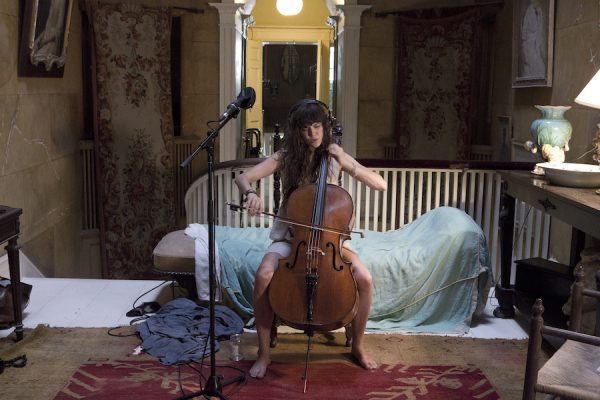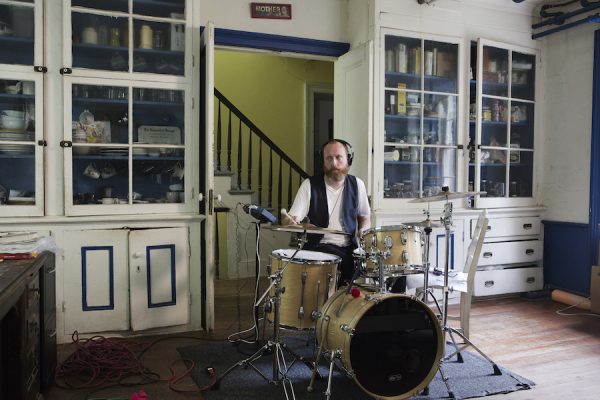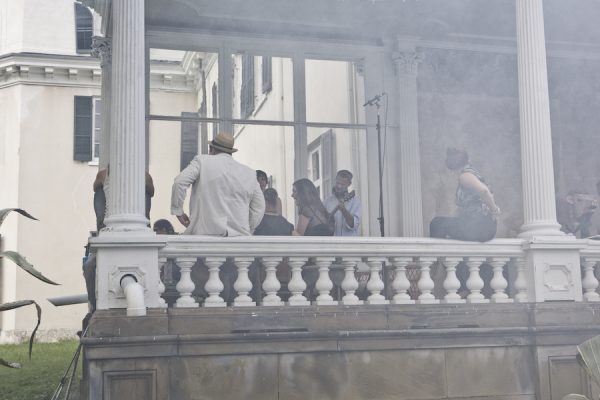
Ragnar Kjartansson, The Visitors, 2012, nine-channel video, 64 minutes, commissioned by the Migros Museum für Gegenwartskunst, Zurich. Photo: Elísabet Davids © Ragnar Kjartansson; courtesy of the artist; Luhring Augustine, New York; and i8 Gallery, Reykjavik
Ragnar Kjartansson’s The Visitors (2012), on view at the Museum of Fine Arts, Houston (MFAH), features nine digital projections in a darkened room showing a group of musicians who perform in and around a large old house, in a single take, a song from the poem Feminine Ways by artist Ásdís Sif Gunnarsdóttir. As is often included in discussions of The Visitors, the poem was written by Kjartansson’s ex-wife in the aftermath of their divorce. The work has been called “immersive,” and it is — the work uses projection, space, and the emotional potency of a pop song to reveal the structure of its production. The title of the work, taken from an ABBA album, also plays with the idea of the performers as visitors in the filming location and the viewer as then a visitor within that psychological space. The performers are friends of the artist, and a few are members of the Icelandic band Sigur Rós. The work rewards long and close viewing and yet remains accessible in brief interludes. While, at 64 minutes, The Visitors is far too long to be a pop song , it nonetheless participates in and exploits how a pop song operates.

Ragnar Kjartansson, The Visitors, 2012, nine-channel video, 64 minutes, commissioned by the Migros Museum für Gegenwartskunst, Zurich. Photo: Elísabet Davids © Ragnar Kjartansson; courtesy of the artist; Luhring Augustine, New York; and i8 Gallery, Reykjavik
“Immersive” succeeds as a description for the installation — through its performances, its use of space, and its emotional charge. There are two screens on either side of a wall near the center of the room with projections on the two long walls and one short wall in the back. Its placement in the MFAH in a rectangular room is a bit of a disservice to the work. I first saw the piece at the ICA Boston a few years ago and remember its installation as being circular and larger. While one can never experience the nine projections at once (no matter how the projections are arranged), the rectangular room bifurcates the installation, separating three projections from the rest. Eight projections feature a solitary performer (one accompanied by a sleeping woman), each seemingly in a different room, and one projection includes a group of performers on a porch — although changes occur within the configurations at various points. As a result, the viewer/listener is constantly moving to see what one has heard from out of sight, encouraging participation (“immersion”) in the installation. Each time you view the piece, there’s the possibility of a different experience. As you watch the projections, Kjartansson begins to reveal the house’s structure and you start to realize, for example, two projections are different spaces within one large room. You also sense that the house’s entirety is just out of reach for the viewer.

Ragnar Kjartansson, The Visitors, 2012, nine-channel video, 64 minutes, commissioned by the Migros Museum für Gegenwartskunst, Zurich. Photo: Elísabet Davids © Ragnar Kjartansson; courtesy of the artist; Luhring Augustine, New York; and i8 Gallery, Reykjavik
The projections are gorgeous; Kjartansson’s canny use of color meets his dive into the Rokeby Farm House in New York’s Hudson Valley, built in 1815. The glamour of the house, once owned by the Astor family, has fallen into ruin. At the MFAH, to enter the installation, you walk through a sculpture gallery featuring 19th-century American works. The song lightly reverberates in the surrounding galleries as you make your way to The Visitors. The sculpture gallery isn’t part of the installation, but there’s a loose correlation between the time period of the house and the works within that gallery space — works that would have likely been in the collections of families like the Astors.
Sixty-four minutes, while long for a pop song, facilitates a kind of protracted pop reverie. There is a beginning and an end to the piece, yet the majority of it places us within a long and seemingly never-ending tune. There are moments we may think it’s over (such as the punctuation of cannon fire) but those are parts of the musical performance. Repetition, typical of pop songs and of Kjartansson’s work, draws you into the both song and the spirit of the installation. You might not know the words, but you quickly learn them through the short song’s continual reiteration. The Visitors’ repetition, similar to the chorus of a pop song, hooks us into sticking around — we stay even though we know the words, and we think we know what’s coming. We see the performers get caught up in the emotional reverie of their performance and the song, and increasingly, we can’t help feeling something, too.
The Visitors’ volume and sound functions to make the viewer feel a correlation between our sense of the gallery space and our understanding of the rooms of the house. We hear something and associate it with one of the projections; if it is out of sight, we move toward it. The experience of the performers on screen and viewers in the museum seems to dovetail. The performers in the house can hear one another through their headphones, although most of them are alone, and the viewer in the museum makes choices about the projections they watch and for how long — together or alone in the gallery space. When I saw it at the MFAH, particularly by the end, my fellow viewers — strangers to one another — moved as a group from projection to projection. The volume crescendos to create the expectation of climactic emotion. The words may or may not have meaning for the listener, but the The Visitors’ melody and the pull of its sound and vocals create a powerful emotional resonance.

Ragnar Kjartansson, The Visitors, 2012, nine-channel video, 64 minutes, commissioned by the Migros Museum für Gegenwartskunst, Zurich. Photo: Elísabet Davids © Ragnar Kjartansson; courtesy of the artist; Luhring Augustine, New York; and i8 Gallery, Reykjavik
The Visitors plays on the tension between hearing and seeing. A viewer can’t both hear and see everything at once. In the work, as the song ends and the performers leave the house and walk into the Hudson Valley countryside, other noises begin to fill the gallery space — some from visible sources and some not: nature sounds, murmurs of the group talking or shouting, a dog barking, a bottle falling. But the now-empty rooms of the house are what you see. Eventually, a man approaches each projection’s camera to shut it off, one by one; each projection goes dark. The time he takes to reach each camera shows us the expanse of the house. This calls back to the beginning of the piece, when we see the cameras turn on and the performers prepare to begin. In the beginning and end, The Visitors makes visible and audible the people in front of and behind of the performance. And as everything slowly winds down and then shuts down, the man turning off the cameras continues to whistle the song we just heard. When all the screens go to black, we begin again.
On view at the Museum of Fine Arts, Houston through September 22, 2019. Note: It is now part of the MFAH’s permanent collection.



1 comment
“The title of the work, taken from an ABBA album” – xoxo, but its great